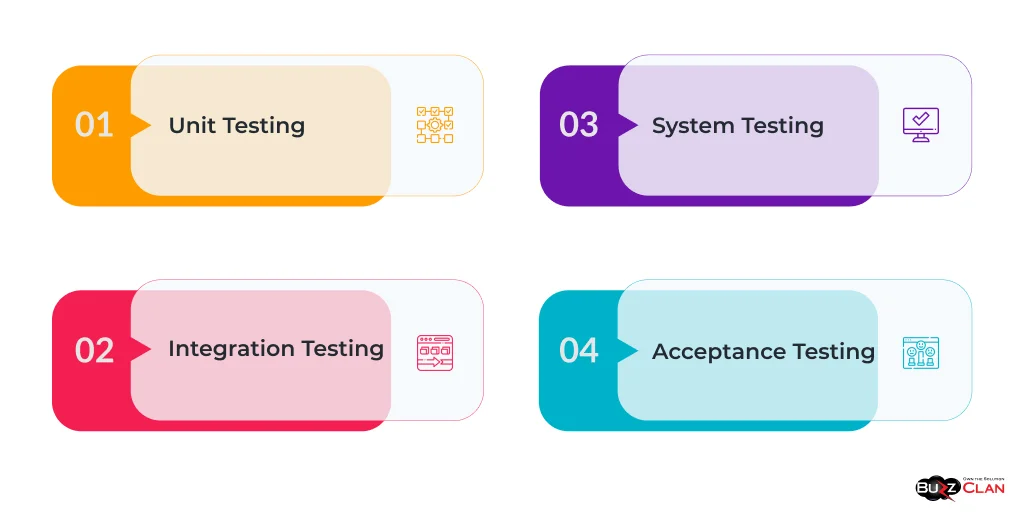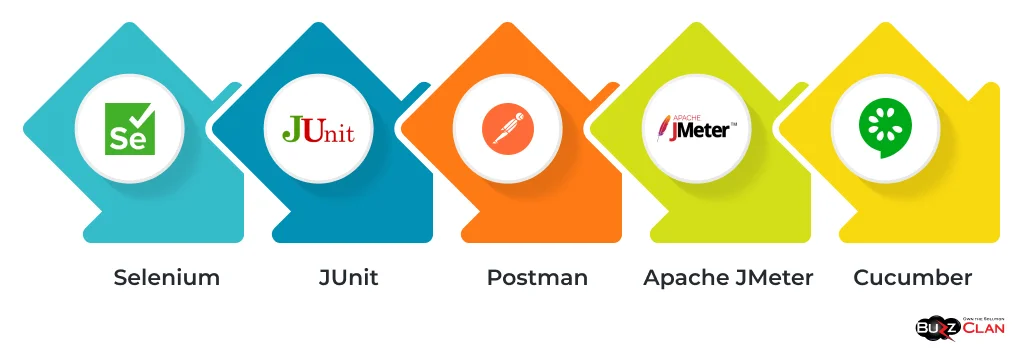Mastering Software Quality: A Guide to Software Testing Types
Om Prakash Gautam
Mar 27, 2024
Introduction
Software testing is integral to the software development life cycle (SDLC). It aims to identify defects, errors, or missing requirements compared to actual needs. It involves executing a software component or system to evaluate one or more properties of interest. Software testing aims to inform stakeholders about the quality of the software product or service under test.
This comprehensive guide will delve into the diverse software testing world, exploring various types and their applications. By understanding the different dimensions of software testing, developers and quality assurance professionals can create robust, reliable, and user-friendly software products.
The Diversity of Software Testing
Classifying Software Testing
Software testing can be classified based on the purpose, level, type, and testing techniques. Understanding these classifications is essential for designing an effective testing strategy that covers all software system aspects.
The Dimensions of Software Testing Types
One fundamental way to categorize software testing is by differentiating between functional and non-functional testing. Functional testing ensures the software system meets the specified requirements and performs the intended functions correctly. Non-functional testing, on the other hand, assesses the system's performance, usability, security, and other quality attributes that are not directly related to its functional requirements.
Functional Testing Types

Unit Testing
Unit Testing is a critical aspect of software development, forming the foundation of the testing pyramid. It involves testing individual units or components of the software in isolation to verify their functionality and ensure they perform as designed. Developers typically write and execute unit tests as part of their development workflow to catch issues early and maintain code quality. Unit testing helps identify and fix defects promptly, reducing the risk of propagating errors to higher levels of testing.
Integration Testing
Integration testing is the next level in the pyramid, focusing on testing the interactions and interfaces between integrated units or components. Its primary goal is to detect faults in integrating different modules and ensure seamless communication and data exchange. A separate QA team usually conducts integration tests after the development process. They help identify integration issues that may arise due to dependencies, communication protocols, or data formats, ensuring the overall system functions as intended.
System Testing
System testing involves testing the entire software system to verify that it meets the specified requirements and works as expected in the user environment. It encompasses testing of both functional and non-functional requirements, including performance, usability, security, and compliance. System testing is typically conducted in a simulated or real-world production environment to assess the system's behavior under various load conditions and user scenarios. It helps ensure the system meets the end user's needs and is ready for deployment.
Acceptance Testing
Acceptance testing is the final stage of functional testing, where the software system is validated against the business requirements. Its purpose is to provide confidence that the system meets the business needs, is acceptable for delivery, and aligns with the stakeholders' expectations. Acceptance testing is usually performed by end-users or stakeholders who deeply understand the business domain and can evaluate the system from a user's perspective. Acceptance testing helps ensure the system is fit for purpose and ready for production use.
Non-Functional Testing Types

Performance Testing
Performance testing evaluates the system's responsiveness and stability under a particular workload. It aims to identify performance bottlenecks, determine a system's scalability, and measure quality attributes such as response time, throughput, and resource utilization.
Security Testing
Security testing aims to identify threats and vulnerabilities in the software system and determine that its data and resources are protected from possible intruders. The purpose of security testing is to ensure that the system is free from any loopholes that might result in unauthorized access, loss of information, revenue, or reputation.
Usability Testing
Usability testing focuses on the user experience, and the ease users can interact with the software. The purpose of usability testing is to ensure the system is user-friendly, intuitive and meets the target audience's needs. End-users or usability experts usually perform usability testing.
Compatibility Testing
Testing verifies the software's cohesiveness across different environments, such as operating systems, hardware platforms, browsers, or network environments. The purpose of compatibility testing is to ensure that the software works as intended in all supported environments.
Specialized Testing Approaches
Manual vs. Automated Testing
Software testing can be performed manually or automated using software tools. A human tester performs manual testing, carefully executes the test steps, compares the actual and expected results, and reports any discrepancies. Automated testing, on the other hand, uses software tools to execute pre-scripted tests and compare the actual results with the expected results.
While manual testing is time-consuming and prone to human error, exploratory and usability testing is necessary. Automated testing is more efficient and can be used for repetitive tasks like regression testing.
Regression Testing
Regression testing ensures that changes or additions to the software have not adversely affected existing features. Its purpose is to catch bugs that may have been introduced accidentally into a new build or release candidate and ensure that previously fixed bugs have not re-emerged.
Smoke Testing
Smoke testing is preliminary testing that reveals simple failures severe enough to reject a prospective software release. It aims to decide if a build is stable enough for further testing. A smoke test generally covers the most important functionality of a component or system.
Advanced Software Testing Types
Model-Based Testing
Model-based testing (MBT) is a software testing technique where test cases are derived from a model that describes some aspects of the system under test. The model is usually an abstract representation of the system's behavior, and the test cases are generated from this model automatically or semi-automatically.
MBT has many benefits, including:
- Improved test coverage: MBT can help ensure that all of the important aspects of the system are tested.
- Reduced test maintenance: MBT can help reduce the time and effort required to maintain test cases.
- Increased test efficiency: MBT can help to improve the efficiency of test execution.
- Improved test quality: MBT can help improve test case quality.
Exploratory Testing
Exploratory testing is a software testing technique where the tester can explore the system under test and create test cases. Exploratory testing is often used with other techniques, such as MBT, to provide a more comprehensive testing approach.
Exploration testing has many benefits, including:
- Increased creativity: Exploratory testing allows the tester to be more creative in their testing approach.
- Improved test coverage: Exploratory testing can help ensure the system is tested impossibly with other testing techniques.
- Reduced test maintenance: Exploratory testing can help reduce the time and effort required to maintain test cases.
- Increased test efficiency: Exploratory testing can help to improve the efficiency of test execution.
- Improved test quality: Exploratory testing can help improve test case quality.
Software Testing in Different Contexts
Agile Testing
Agile testing is a software testing approach aligned with Agile development principles. In Agile, testing is not a separate phase but an integral part of software development and coding. Agile testing is performed concurrently with development activities, preferably daily. This approach allows for early detection of defects and provides continuous feedback to the development team, enabling them to make necessary adjustments promptly.
Benefits of Agile Testing
- Early Detection of Defects: Agile testing helps identify defects early in the development process, allowing for timely resolution and reducing the cost of fixing defects later in the cycle.
- Continuous Feedback: Agile testing provides continuous feedback to the development team, enabling them to make necessary adjustments promptly and ensuring that the software meets the requirements.
- Improved Quality: Agile testing helps improve the overall quality of the software by identifying and resolving defects early, resulting in a more reliable and stable product.
- Increased Productivity: Agile testing can increase productivity by reducing the time and effort required to fix defects and improving communication and collaboration between the development and testing teams.
DevOps and Continuous Testing
DevOps is a software development approach emphasizing collaboration and communication between development, testing, and operations teams. Continuous testing is an essential component of DevOps, as it allows for automated tests to be executed as part of the software delivery pipeline. This provides immediate feedback on the business risks associated with a software release candidate and ensures that quality is built into the software from the start.
Benefits of Continuous Testing
- Faster Feedback: Continuous testing provides faster feedback on the quality of the software, enabling the development team to make necessary adjustments quickly.
- Improved Quality: Continuous testing helps improve the overall quality of the software by identifying and resolving defects early.
- Reduced Risk: Continuous testing reduces the risk of deploying defective software to production by providing early warning of potential issues.
- Increased Agility: Continuous testing enables organizations to be more agile and responsive to changing business needs, as they can quickly adapt their software to meet new requirements.
Software Testing Tools and Technologies

Selenium
Selenium is an open-source automated testing framework for web applications. It supports testing across different browsers, operating systems, and programming languages. Selenium provides a rich set of commands and APIs that allow testers to simulate user interactions, such as clicking buttons, entering text, and navigating through web pages. Additionally, Selenium can be integrated with various reporting and logging tools to provide detailed test results and insights.
JUnit
JUnit is a unit testing framework for the Java programming language. Java developers widely use it to test their code at the unit level. JUnit provides annotations and assertions that make writing and organizing test cases easy. It also supports test runners that can automatically discover and execute test cases and generate test reports. JUnit is an essential tool for ensuring the quality and reliability of Java code.
Postman
Postman is a popular API testing tool that enables testers to send API requests, inspect responses, and validate results. It provides a user-friendly interface and supports various requests, including GET, POST, PUT, and DELETE. Postman offers features like mock servers, test scripts, and documentation generation, making it a comprehensive API testing and development solution.
Apache JMeter
Apache JMeter is an open-source load and performance testing tool. It is widely used to test the performance of web applications, web services, and other distributed systems under load. JMeter can simulate many concurrent users and generate realistic test scenarios to evaluate the system's scalability, latency, and throughput. It also provides reporting and visualization capabilities to help testers analyze the test results and identify performance bottlenecks.
Cucumber
Cucumber is a tool that supports Behavior-Driven Development (BDD), a software development process that emphasizes collaboration between stakeholders and developers. It uses Gherkin's natural language-like syntax to define test scenarios and expected outcomes. It integrates with various testing frameworks, such as Selenium and JUnit, to execute these scenarios and generate test reports. Cucumber promotes a shared understanding of the system's behavior and facilitates communication between technical and non-technical teams.
These are just a few of the many tools available for software testing. The choice of tool depends on the specific testing needs, such as the type of application, the programming language, and the desired level of automation. By leveraging these tools effectively, testers can improve their software applications' quality, reliability, and performance.
Choosing the Right Tools
When choosing software testing tools, consider factors such as the type of testing required, the technology stack of the application under test, the skill set of the testing team, and the budget. It's important to select tools that integrate well with your development process and provide the necessary features and support for your testing needs.
The Future of Software Testing & Emerging Trends in Software Testing
As software development evolves, so does the field of software testing. Some emerging trends in software testing include:
- AI and Machine Learning: These technologies automate and optimize testing processes, such as test case generation, defect prediction, and test suite optimization.
- Blockchain Testing: With the growing adoption of blockchain technology, there is a rising need for specialized testing techniques to ensure the security, performance, and functionality of blockchain-based systems.
- IoT Testing: As the Internet of Things (IoT) grows, testing these complex, interconnected systems becomes increasingly challenging. New testing approaches are needed to ensure IoT devices and ecosystems' reliability, security, and performance.
Continuous Learning and Adaptation
To stay ahead in software testing, testing professionals must continuously learn and adapt to new technologies, methodologies, and best practices. This can involve attending conferences, workshops, and training sessions and participating in online communities and forums.
Conclusion
Software testing is a multifaceted discipline encompassing various types, techniques, and approaches. By understanding the different dimensions of software testing and applying the appropriate types based on the specific needs of a project, software development teams can ensure the delivery of high-quality, reliable, and user-friendly software products.
As the software industry evolves, testing professionals must stay up-to-date with the latest trends, tools, and best practices in software testing. By embracing a mindset of continuous learning and adaptation, testers can effectively navigate the ever-changing landscape of software development and contribute to the success of their organizations.
FAQs

Get In Touch
